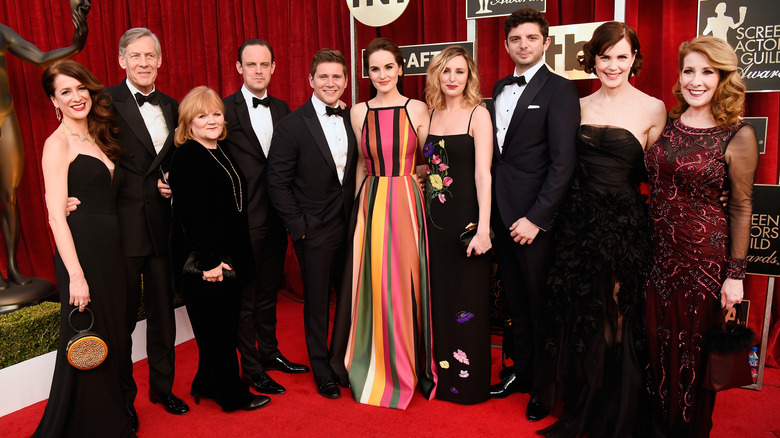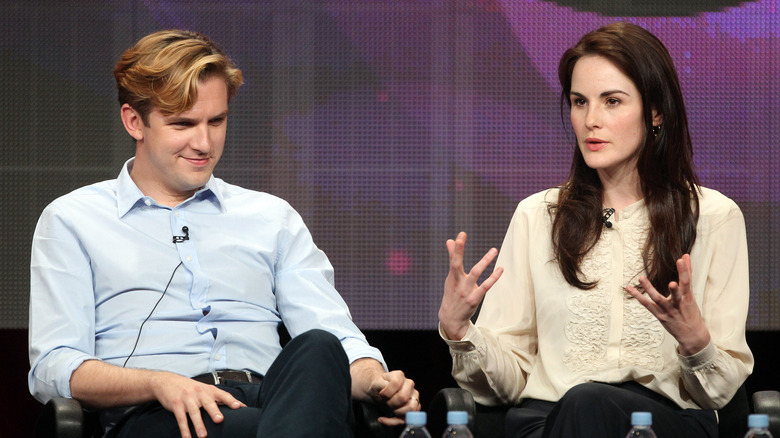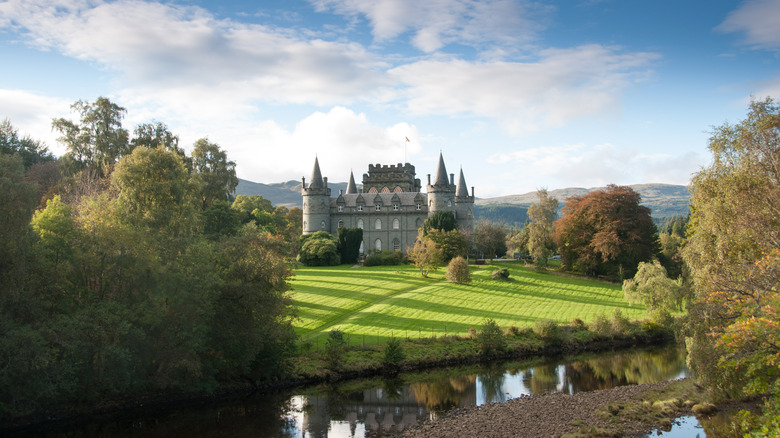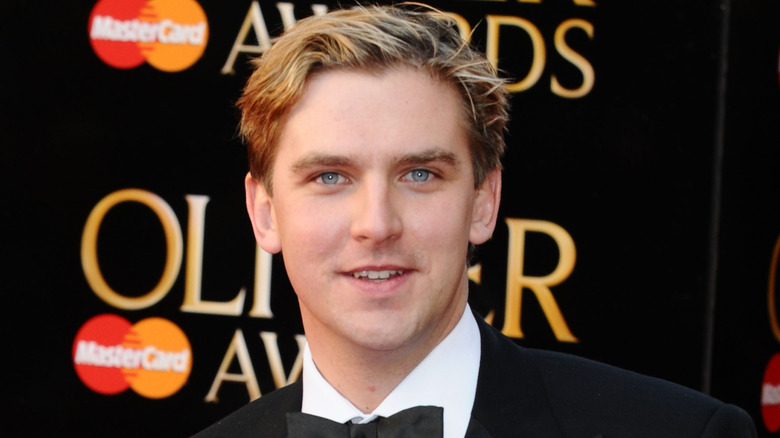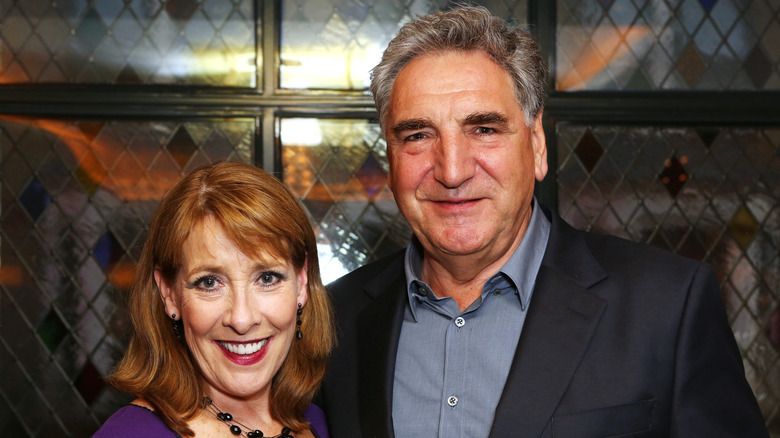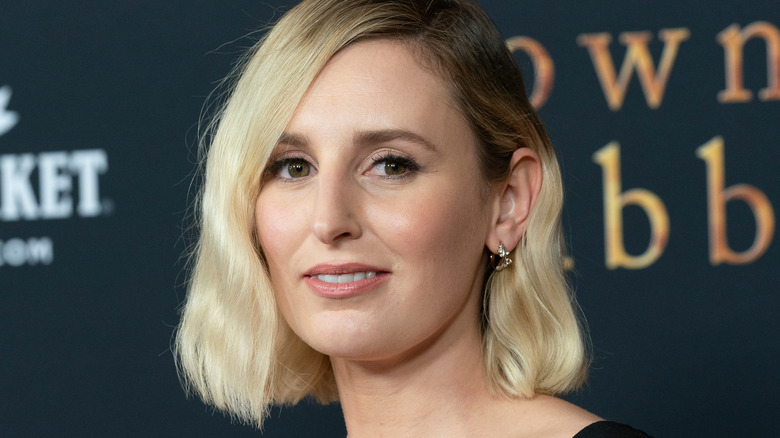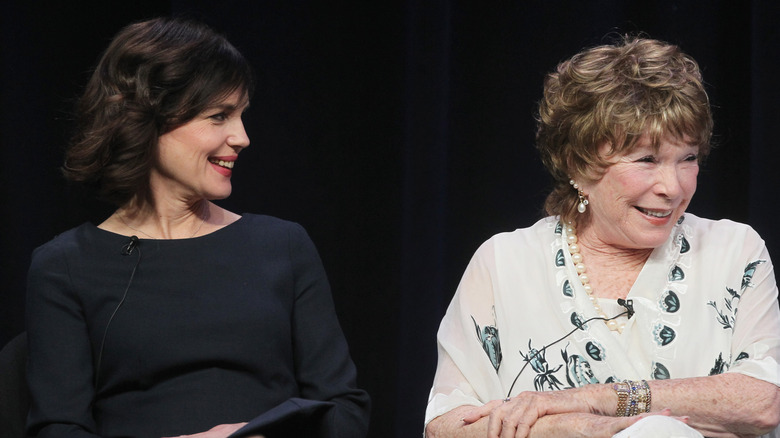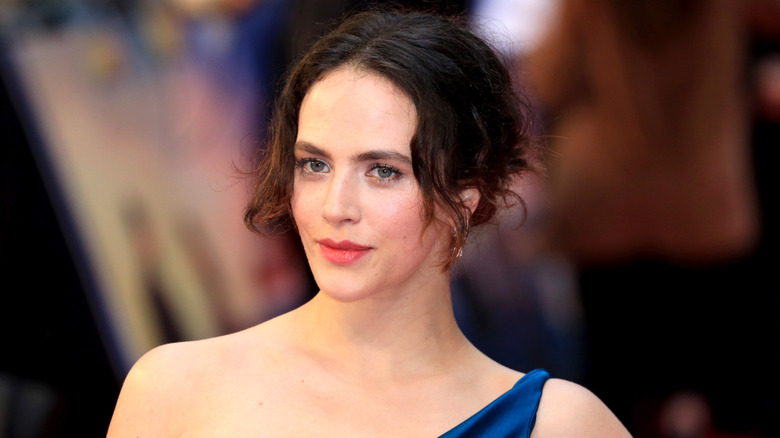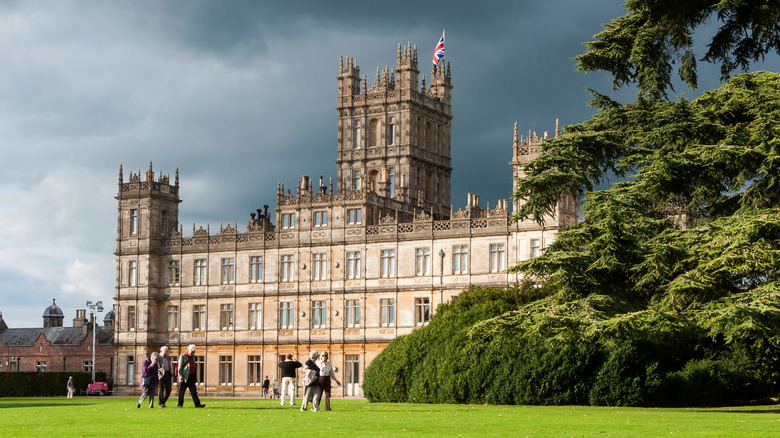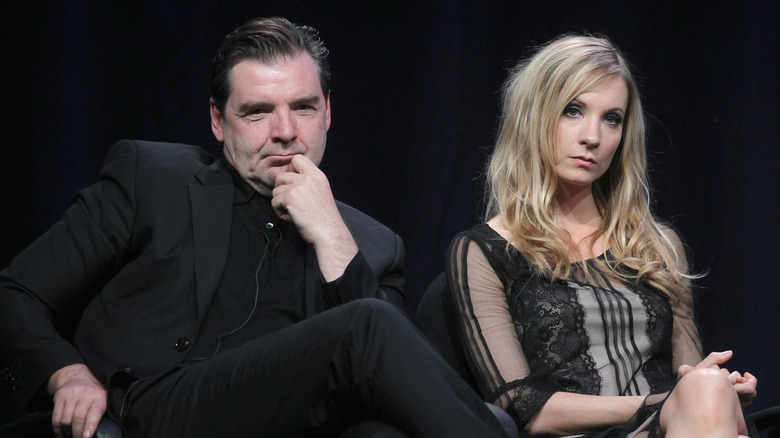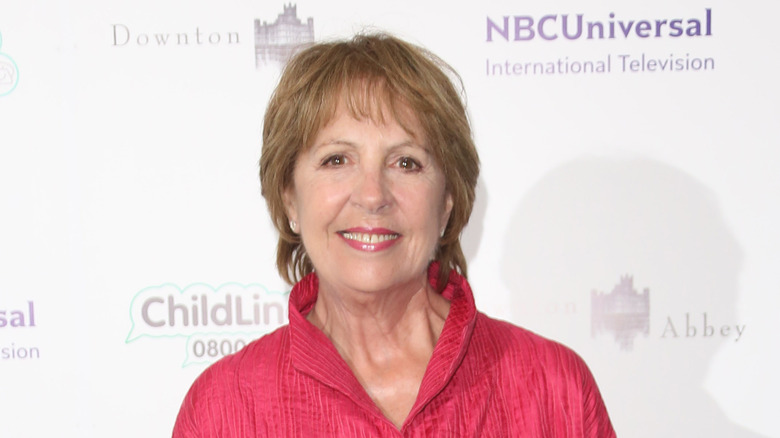A Look Behind Some Of The Most Unforgettable Downton Abbey Scenes
The following article includes a discussion of sexual assault.
"Downton Abbey" is the most successful show in the history of British television, and enjoyed a global viewership of over 120 million, numerous major awards, and an estimated $250 million in global merchandising revenue. The beloved show ran for six seasons and produced two feature films that continued the franchise after the show ended. If fans could have their way, the story of the Earl of Grantham, his home, and his family would continue indefinitely. The cast has hinted that it's an open-ended possibility, according to British Period Dramas.
If you ask any true fan their favorite scene, they will likely have a few contenders to offer. Fans clamored for the lavish sets, luxurious costumes, and soap opera-style drama that often left us with tears and cliffhangers at the close of each season. The show's creator Julian Fellowes spared no expense to bring the stories to life, and he revealed in his 2011 book "The World of Downton Abbey" that each episode cost over 1 million pounds to make (via Yahoo).
The show had an ensemble cast of over 30 actors, with group scenes that often included 10 to 15 actors and scenes that could take up to 12 hours to shoot, according to Movie Raze (via YouTube). Let's dive deeper into some of the most memorable scenes from the hit show, and see what the cast has said behind the scenes about working on some of our favorite "Downton Abbey" moments.
Matthew's proposal to Mary
Season 2 had fans on edge with the addition of Mary's potential love interest Richard Carlisle. It was clear that Carlisle wasn't the right match for Mary, and there were clear signs that she was acting out of obligation to him for burying her unfortunate and scandalous story with Mr. Pamuk. However, the "Downton Abbey" Christmas episode, which aired after the close of Season 2, gave fans the resolution they had been yearning for: Matthew's proposal to Mary.
Mary and Blake Media named this scene the most romantic scene in television, because Matthew and Lady Mary's progressive relationship allowed the proposal to be Lady Mary's choice and not her obligation. "There's no pomp and circumstance. There's no rule book. There's no expectation baked into the question like a marriage proposal has. It's just a question that has been boiled down to its very core – will you stay in my life?"
In an interview with What's On TV, actor Dan Stevens disclosed that he was satisfied for his character's journey and proud of the entire Christmas episode. "I honestly think it's our best episode we've ever done." He continued, "The structure of it and the resolution of some of the storylines for the characters. It feels nice to watch." Stevens referred to Season 2 as "grim" and felt the viewers would be relieved to see brighter turns to some of the darker storylines.
The Ghillies Ball
Fans couldn't get enough of the opulence that was portrayed in "Downton Abbey." The Christmas episode that closed out Season 3 took the entire cast to Duneagle Castle to visit the Marquess and Marchioness of Flintshire, also known as Susan and "Shrimpie" MacClare. The episode also featured a celebration called the Ghillies Ball, but unlike the fictional name Duneagle, the Ghillies Ball is a real event with over 150 years of royal history.
According to Town & Country, Queen Victoria began throwing Ghillies Balls in 1852, when she and Prince Albert purchased Balmoral Castle. The Queen held the celebration in September of that year to thank her staff and servants, and the annual tradition was born. A ghillie refers to a shoe used for dancing, and it is also a Gaelic term for "gamekeeper." The Royal Family described the Ghillies Ball as one of Queen Elizabeth II's favorite hobbies, and she upheld the annual tradition at Balmoral for neighbors, estate, and Castle staff.
The fictional Duneagle Castle was actually set at Inveraray Castle in Inveraray, Scotland. Described as a "modern, baroque, Palladian and Gothic-style castle," it is traditionally the home of the Duke and Duchess of Argyll. The castle staff were incredibly proud to show off the estate for the fictional show: "Inveraray Castle was shown at its best, with magnificent shots of the castle, gardens and surroundings."
Matthew's death
Just when fans had settled into a cozy place with Matthew and Lady Mary's love story, the writers took it all away with an unexpected tragedy. On the day of their son's birth, Matthew has a fatal car accident while driving home from the hospital. Fans were downright distraught over the plot twist. One YouTuber lamented, "I have never, and I mean NEVER, been more shocked by anything that happened on a tv show than I was when Matthew died. I actually leapt from my seat, threw my pillow on the ground and yelled!"
According to Movie Raze, the cast didn't receive the Christmas episode script until a week before filming to keep the death plotline a secret. Although the episode aired in 2012, Dan Stevens was still showing remorse to fans in 2017 for his departure from the show. "The way Matthew went was out of my hands." He continued, "I've had to apologize to a lot of people over the past four years."
Then, in a tragic offscreen twist of fate, actress Michelle Dockery (Lady Mary) also lost her true love. Dockery and PR executive John Dineen were engaged to be married when Dineen passed away from a rare form of brain cancer in December 2015. "One of the difficult things at the time was the parallels with Mary," Dockery said to the Daily Mail. "It was just baffling, and still is to me, that my character's storyline was so similar."
Carson and Mrs. Hughes at the beach
The show was known for its dramatic finales, but season 4 had one storyline that finished with a romantic delicacy that became a fan favorite. We were more than ready for the first glimpse of the eventual romance between Carson and Mrs. Hughes when the pair waded into the sea hand-in-hand on the special beach day that Carson planned for the staff. The show received criticism after Matthew's death, and the tender moment between the pair (which the Los Angeles Times described as the "heart and soul" of the house) was "a wonderful, unexpected and quietly thrilling way to wind down the season."
In a 2013 interview with the Daily Mail, it was clear that the future romance hadn't been revealed to the cast when actor Jim Carter (Carson) denied the potential relationship. "I love doing the scenes with Phyllis Logan – the scenes between them both are very nice – but traditionally housekeepers and butlers didn't marry." He went on to unintentionally predict the eventual series ending for the two characters. "They were traditionally bachelors and spinsters. So if we did get together, we would have to retire to a rose-covered cottage."
Actress Phyllis Logan (Mrs. Hughes) was equally surprised by the colleague-turned-couple twist, but knew it was the best path to please the fan base. In 2015, she told The Express, "I think we owe it to our public. Yes, I think it's crying out for a bit of middle-age romance."
Lady Edith was jilted
It seemed that Lady Edith might finally get some happiness of her own when she was set to marry Sir Anthony Strallan. However, the family had been undermining the relationship because of the couple's age difference. By the time the ceremony began, Sir Anthony was convinced he was dooming Lady Edith, and declared, "I can't do this!" — leaving Lady Edith jilted at the altar.
Despite the scripted storyline of a wedding that never was, the Emmy-winning costume designer Caroline McCall still dressed Lady Edith beautifully for the episode. Her wedding dress was a Grecian style that draped beautifully on actress Laura Carmichael's frame. McCall told Elle that she it made it a point to avoid the idea of "awkward Edith." Instead, she wanted Downton fans to see Lady Edith and say, "Wow, she looks fantastic."
The notoriously miserable relationship between Lady Edith and Lady Mary didn't improve, despite the opportunity for Mary to console her sister and show a softer side. But Carmichael explained that the characters stayed true to form in the way they handled the aftermath of the jilting. The sisters are "not modern where they're going to hug and cry it out," she told Vanity Fair. "This is an aristocracy, and their relationship is just a maze. It's difficult."
When Martha Levinson came to Downton
One of the smartest and most beloved casting choices was bringing Shirley MacLaine in as Martha Levinson, Lady Cora Crawley's tart-mouthed American mother. She made her first appearance in season 3 when she visited for Matthew and Lady Mary's wedding. The actress had to hold her own against the great Dame Maggie Smith, because the two were set to do some on-screen sparring. But MacLaine told the Daily Mail that the barbs were meant to be "more sophisticated and adult," adding that her character "is really trying to explain to her that you really must grow up and out of this addiction to tradition because this is what got you into the world war."
Despite never having worked together until "Downton Abbey," MacLaine referred to the duo as two "senior citizens" who liked to sit around gossiping about all their famous friends. Hugh Bonneville (Robert Crawley) recalled that he wanted to pinch himself. "I can't believe I was sitting between these two great legends, and them chatting about the work they've done with some icons of the screen and stage like Olivier and Gene Kelly" (via YouTube).
Robert James-Collier (Thomas) told The Celeb Factory that he had to adjust his attitude when MacLaine arrived. "I think because she's so iconic, I might have built her up unfairly." He thought she may be an aloof Hollywood type, but explained, "When she got here was totally one of the team straight away – sat with us having tea, biscuits."
Lady Sybil's death
The show didn't shy away from goodbyes, and over the seasons, fans had to say farewell to a few integral characters, sometimes unexpectedly. But for many fans, the death of the Earl's youngest daughter in season 3 was the most devastating and heart-wrenching to watch. Lady Sybil was diagnosed with pre-eclampsia during labor, and after she successfully delivered a healthy baby girl, her condition quickly deteriorated — and mere minutes later, she died from complications.
Sybil's legacy seemed to linger and affect the show until the very end, all the way into the feature films. The show's executive producer Gareth Naeme described how the character's death broke everyone's heart, and referred to England as "a nation gobsmacked" to Vulture.
It was reportedly a somber setting for the cast when filming the now-infamous episode. Actor Allen Leech told Huffington Post, "It was really difficult to film because it happened over two days and was really just emotionally draining to shoot." He revealed the extreme sadness of having to film a scene that required crying for 10 hours. "By the end of it, it was just me crying because I was just tired of crying," Leech explained. Jessica Brown Findlay, who plays Lady Sybil, said her own parents struggled with the character's ending. "Even my parents knew I was dying, but they didn't know how, so my mum was in bits. My dad had to tell her, 'you can call her on the phone.'"
Downton became a convalescent home
"Downton Abbey" took place from 1912 to 1925, and included the First World War in its story. A few of the characters served on behalf of England, and season 2 opened with Matthew fighting in the Battle of Somme. One of the most memorable sets was when Downton Abbey was transitioned to a convalescent home during the war. The shift of focus to wounded soldiers in the Abbey added an exciting element to the show by allowing the war to weave directly into the Abbey story, according to Town & Country.
Highclere Castle in Newbury was used to shoot scenes for the fictional Downton Abbey. It turns out art imitated life in this instance, as Highclere also became a hospital during the war beginning in September 1914, according to Country Life. The 5th Countess of Carnarvon reportedly offered soldiers "food, wine, and brandy," and also took the time to send long telegraphs to communicate updates to their families. Lady Almina is credited with saving the lives and limbs of many soldiers while her home served as a hospital.
It was common for the stately homes of the wealthy and aristocrats to be utilized as hospitals during World War I. Highclere Castle, like Downton, also saw many of its staff go to war, although many Highclere staff never returned. The castle was not returned to a private residence until 1922 (via Country Life).
The disturbing attack on Anna Bates
Season 4 featured a controversial storyline that many viewers felt crossed the line when lady's maid Anna Bates was beaten and raped by valet Alex Green. The assault is acted off camera, but viewers could still hear the violent attack.
BBC reported that ITV received 60 complaints from distressed viewers. Creator Julian Fellowes insisted that no subject is ever portrayed gratuitously on the show. He defended the inclusion of the attack because he wanted viewers to be able to explore the mental and emotional damage of sexual assault with Anna. Critics of this assertion claim that Anna never processed the attack onscreen, and that her only subsequent actions were to keep the attack hidden from her husband, Bates.
Joanne Froggatt (Anna) agreed with Fellowes that the subject matter was worthy of being aired, and said of the cast and crew, "We all felt a big responsibility to get it right." Froggatt also said that it was important in later episodes to show the ongoing relationship development between Anna and Bates following the attack. But Time contends that the storyline was "fridging," which is "the practice of doing something horrific or tragic to a female character with the sole objective of causing an emotional reaction from the male lead of a storyline."
If you or anyone you know has been a victim of sexual assault, help is available. Visit the Rape, Abuse & Incest National Network website or contact RAINN's National Helpline at 1-800-656-HOPE (4673).
Lady Violet defends Isobel
It's hard to believe the heartfelt moments of the final season between Lady Violet (Dame Maggie Smith) and Isobel (Penelope Wilton) after their frosty beginning in season 1. Fans loved the onscreen bantering between the show's revered elders, but the pair eventually came to respect each other and be close companions.
One of the most satisfying scenes for the duo was in the final season, when Lady Violet helped Isobel get the upper hand with Lord Merton's son and wife. They were practically invincible together in this scene, bolstered by the advice of Lady Violet's late father: "If reason fails, try force!" The long-term implications of this scene also bring the friends full circle, when Isobel eventually marries Lord Merton and becomes a Lady alongside her bestie, Violet.
Wilton told Huffington Post that she and Smith did not rehearse scenes prior to filming them, so that the actresses could figure out the depth of the scene spontaneously. Despite their on-screen bickering, the real-life actresses adored each other. In a featurette about the show, Wilton said, "When I was a young woman when I was starting out, the person I admired more than anyone was Maggie Smith. I saw her in everything at the National Theatre" (via YouTube). She added, "It's like working with a heroine."
